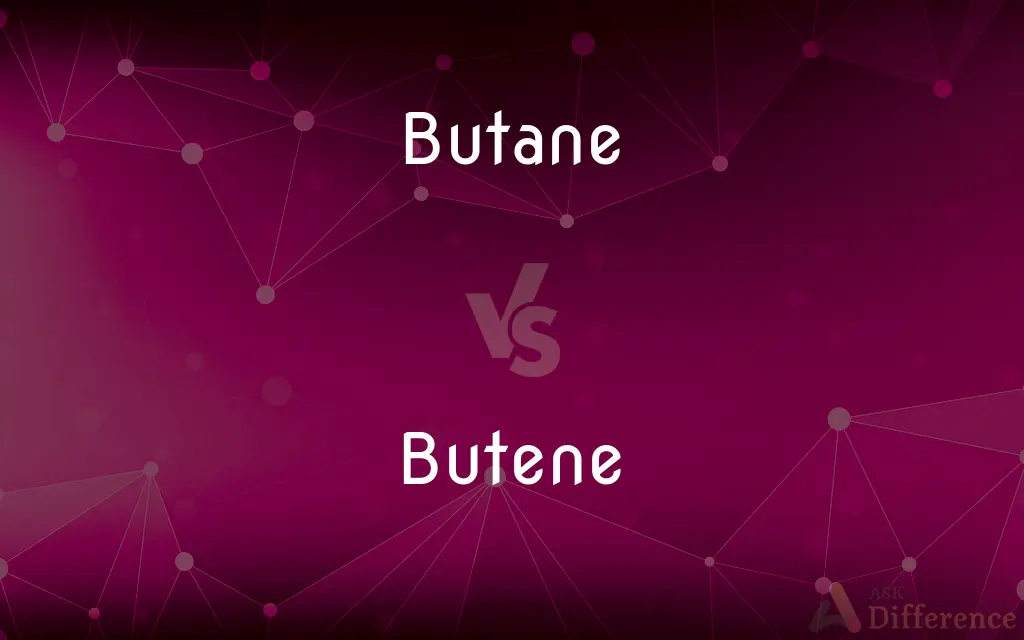Butane vs. Butene — What's the Difference?
Edited by Tayyaba Rehman — By Fiza Rafique — Updated on September 27, 2023
Butane is a saturated hydrocarbon with four carbon atoms, while Butene is an unsaturated hydrocarbon containing a double bond between its carbon atoms.

Difference Between Butane and Butene
Table of Contents
ADVERTISEMENT
Key Differences
Butane and Butene, both hydrocarbons, have differing chemical structures and properties. Butane, characterized by its single bonds between carbon atoms, belongs to the alkane family. In contrast, Butene is part of the alkene family, showcasing a double bond between two of its carbon atoms.
In practical applications, Butane is commonly used as a fuel in lighters and portable stoves. Butene, given its double bond, serves as a building block in the petrochemical industry, especially in polymer production.
Regarding their physical properties, Butane is known to be a gas at room temperature under atmospheric pressure and is flammable. Butene, though also flammable, has variants based on the position of its double bond, leading to isomers like 1-butene and 2-butene.
In chemical reactions, Butane generally undergoes substitution reactions, given its saturated nature. On the other hand, the presence of a double bond in Butene allows it to partake in addition reactions, highlighting its unsaturated nature.
Chemically, while both are derivatives of crude oil and find their roles in the petrochemical industry, their functions and importance vary greatly due to their structural differences and consequent chemical behaviors.
ADVERTISEMENT
Comparison Chart
Chemical Family
Alkane
Alkene
Bond Type
Single bonds
Contains a double bond
Common Use
Fuel in lighters, stoves
Building block in petrochemicals
Physical State
Gas at room temperature
Gas with various isomers
Reaction Type
Substitution reactions
Addition reactions
Compare with Definitions
Butane
A fuel used in portable stoves.
For camping, she bought a Butane stove.
Butene
A building block in the chemical industry.
Butene is used in producing polymers and other chemicals.
Butane
An alkane with four carbon atoms.
Butane's chemical formula is C₄H₁₀.
Butene
An alkene with four carbon atoms.
Butene can have isomers based on the position of its double bond.
Butane
A saturated hydrocarbon gas.
Butane lighters are popular due to their reliability.
Butene
A gas with variants like 1-butene and 2-butene.
The isomer 1-butene has its double bond at the first carbon.
Butane
A flammable gas used commercially.
The Butane cylinder needs careful handling due to its flammability.
Butene
An unsaturated hydrocarbon with a double bond.
Butene's presence in crude oil makes it valuable for petrochemicals.
Butane
Butane () or n-butane is an alkane with the formula C4H10. Butane is a gas at room temperature and atmospheric pressure.
Butene
Known for undergoing addition reactions.
Due to its unsaturated nature, Butene can react with bromine in an addition reaction.
Butane
Either of two isomers of a gaseous hydrocarbon, C4H10, produced synthetically from petroleum and used as a household fuel, refrigerant, and aerosol propellant and in the manufacture of synthetic rubber.
Butene
Butene, also known as butylene, is an alkene with the formula C4H8. The word butene may refer to any of the individual compounds.
Butane
(organic compound) A hydrocarbon (either of the two isomers of C4H10 n-butane, and 2-methyl-propane) found in gaseous petroleum fractions.
Butene
Any of three gaseous isomeric ethylene hydrocarbons, C4H8, used principally in making synthetic rubbers. Also called butylene.
Butane
The n-butane isomer only.
Butene
(chemistry) Any of several forms of butylene.
Butane
An inflammable gaseous saturated hydrocarbon, C4H10, of the marsh gas, or paraffin, series.
Butene
Any of three isomeric singly unsaturated hydrocarbons C4H8; all are used in making synthetic rubbers; - called also butylene.
Butane
Occurs in natural gas; used in the manufacture of rubber and fuels
Butene
Any of three isomeric hydrocarbons C4H8; all used in making synthetic rubbers
Butane
A derivative of natural gas.
Natural gas processing plants extract Butane for various applications.
Common Curiosities
What is Butane commonly used for?
Butane is commonly used as a fuel, especially in lighters and portable stoves.
Are both Butane and Butene gases?
Yes, both Butane and Butene are gases at room temperature under atmospheric pressure.
Why is Butene significant in the petrochemical industry?
Butene, with its double bond, serves as a building block for various chemicals, especially polymers.
How does Butene differ from Butane in chemical structure?
Butene has a double bond between its carbon atoms, while Butane only has single bonds.
Why can Butene undergo addition reactions?
Due to its unsaturated nature with a double bond, Butene can undergo addition reactions.
What kind of reactions does Butane usually undergo?
Being an alkane, Butane generally undergoes substitution reactions.
Is Butane an alkane or alkene?
Butane is an alkane, characterized by single bonds between its carbon atoms.
How many carbon atoms are in Butane and Butene?
Both Butane and Butene contain four carbon atoms.
Is Butane found naturally?
Yes, Butane is derived from natural gas and is also found in crude oil.
Does Butene have isomers?
Yes, Butene has isomers like 1-butene and 2-butene based on the position of its double bond.
In which reactions does Butene often participate?
Butene often participates in addition reactions due to its alkene nature.
Between Butane and Butene, which one is saturated?
Butane is saturated, having only single bonds, while Butene is unsaturated due to its double bond.
What is the significance of the double bond in Butene?
The double bond in Butene allows it to partake in addition reactions and determines its isomeric forms.
Are both Butane and Butene flammable?
Yes, both Butane and Butene are flammable gases.
How is Butene utilized in polymers?
Butene serves as a monomer or building block in the production of certain polymers.
Share Your Discovery

Previous Comparison
Point vs. Vertex
Next Comparison
Clanger vs. ClapperAuthor Spotlight
Written by
Fiza RafiqueFiza Rafique is a skilled content writer at AskDifference.com, where she meticulously refines and enhances written pieces. Drawing from her vast editorial expertise, Fiza ensures clarity, accuracy, and precision in every article. Passionate about language, she continually seeks to elevate the quality of content for readers worldwide.
Edited by
Tayyaba RehmanTayyaba Rehman is a distinguished writer, currently serving as a primary contributor to askdifference.com. As a researcher in semantics and etymology, Tayyaba's passion for the complexity of languages and their distinctions has found a perfect home on the platform. Tayyaba delves into the intricacies of language, distinguishing between commonly confused words and phrases, thereby providing clarity for readers worldwide.













































